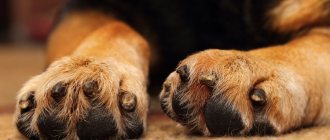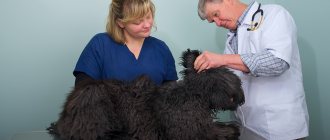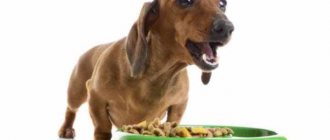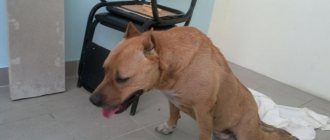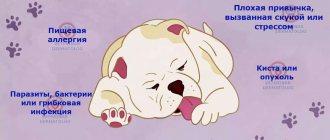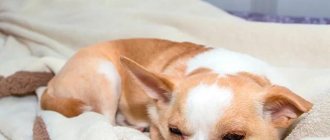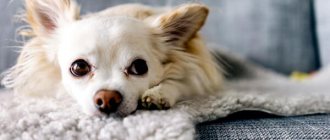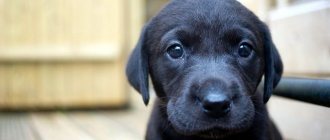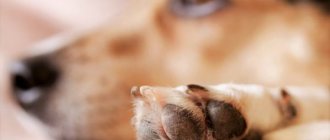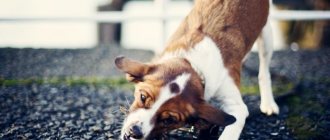Most dogs lick their paws. This is a completely natural grooming process, in this way they remove foreign objects stuck after a walk and clean the fur of dirt. The usual cleaning procedure should alert the owner if the dog bites its paws. Scratching to the point of bleeding, redness and alopecia on the limbs are especially dangerous. If such symptoms are detected, you should carefully examine the animal and contact a veterinarian to determine the causes and prescribe treatment.
Main reasons
There are several reasons why a dog may begin to constantly chew and bite its back legs. Often this problem is caused by physiological factors and non-compliance with maintenance rules:
- poor-quality care - the owner does not clean the dog after walks, does not trim its nails regularly;
- contact with reagents that are sprinkled on ice in winter;
- unbalanced diet, lack of sufficient protein, vitamins and minerals in the diet;
- mechanical damage to the skin, abrasions and splinters.
These difficulties can be easily resolved on your own, without visiting a veterinary clinic. It is enough to monitor the pet’s condition and conduct regular examinations. The dog may begin to actively lick and chew its paws due to illness. A similar symptom is characteristic of the following diseases:
- food or contact allergies;
- neurosis (against the background of it, not only the paws are gnawing, but also the tail);
- subcutaneous mite, demodicosis;
- fungal infection;
- circulatory disorders;
- joint diseases, displacement of spinal discs;
- atopic dermatitis.
To accurately determine the cause, high-quality diagnostics are recommended. That is why it is important to contact a veterinarian in a timely manner and undergo a routine examination at least twice a year. If a dog bites its paws for a long time, it can result in tissue infection, inflammation and even necrosis.
Why shouldn't you hesitate?
If the habit of chewing paws is not due to discomfort as a result of a wound or the growth of claws, but is a direct consequence of deteriorating health, then delay can lead to serious complications.
- The fungus leads to rotting of the finger pads, which means the dog may forever lose the ability to move normally.
- Inflammation of the nail bed can lead to general blood infection if the pus is not removed in time.
- Contact allergies to chemicals and reagents can cause splitting of the skin on the paw pads, leaving the animal disabled.
To make an accurate diagnosis and eliminate the causes, you should immediately contact your veterinarian.
The veterinarian will be able to prevent such consequences.
How to recognize the problem?
Caring for your paws is a natural hygiene procedure for any dog. A deviation is considered if the desire to lick the limbs becomes obsessive, the animal often gnaws the pads for a long time. To detect the problem, you should inspect your dog's paws regularly. They should be free of persistent dirt, signs of injury and other mechanical damage. The following signs are unacceptable:
- presence of blood;
- inflamed and weeping areas of the skin;
- dry crusts on the pads;
- traces of alopecia (hair loss);
- change in dog behavior;
- refusal of food, games.
Be sure to pay attention to any deviations in your pet’s usual behavior. You should consult a doctor if your dog becomes aggressive or apathetic (when he chews), refuses food and even his favorite treats. The problem can be especially dangerous if the pet begins to growl and grin, and does not allow him to approach him during the next licking of his paws.
Inspection of a dog's paws should be done carefully. Even the slightest touch of the paws can be painful and uncomfortable for the dog. You need to be careful when touching the paws of older pets - the problem may arise due to age-related joint diseases.
Photo: thehappypuppysite.com
Treatment and treatment at home
In the early stages, when there is no severe tissue damage in the area of the pads, treatment can be carried out at home. The main rule is high-quality care for your pet’s paws, as well as timely treatment when gnawing. Algorithm of actions:
- Carefully examine the area that the dog is licking (pads, fur on the bend of the limb, fingers).
- Remove any visible dirt with a cotton pad soaked in clean water.
- Trim off excess hair and shorten the length of nails if possible.
- Treat the skin with any antiseptic solution (Miramistin, Chlorhexidine, Furacilin).
- If there is bleeding, apply a cotton pad with hydrogen peroxide and secure it with a special adhesive bandage. It is recommended to additionally wear a muzzle or an Elizabethan collar.
It is recommended to carry out treatment after each walk, at least 2 times a day. If there are no visible improvements within 2-3 days, then contact a veterinary clinic.
A dog chews its tail: treatment for fleas
The fact is that in the area where the body transitions to the tail, there are a large number of sebaceous glands that attract parasites. It is in this area, as well as near the ears, that fleas can be found. Accordingly, they are active there and can bite the pet. This is why the dog chases its tail in an attempt to fight off parasites.
It sometimes happens that the dog chews this area until it bleeds. The easiest way to get rid of it is to use special shampoos. Fortunately, there are now a huge number of remedies for fleas and other parasites in veterinary pharmacies. But, try not to wait for parasites to appear in your dog, but try to prevent their occurrence. That is, it is necessary to wash the dog with flea shampoo for prevention. Once you remove the parasites, your dog will most likely stop chewing his tail.
List of flea remedies:
- Bars - antiparasitic drops for dogs
- Actofit - bioinsecticide
- Hartz Drops 3in1 against fleas and ticks for dogs
- Repellent spray Outdoor with aloe vera for dogs
- Bayer Advantix anti-parasite drops for dogs
Beautiful pet
When to contact the clinic?
You should consult a doctor if your dog chews its paws hard and often until it bleeds, or if there are signs of tissue damage. In this situation, early treatment can prevent dangerous complications, so if you cannot cope with the problem on your own, you need to urgently make an appointment. One of the main purposes of the treatment is diagnostics, which allows us to identify the reason why the dog chews itself. Basic research methods:
- visual examination, collection of the dog’s medical history through an interview with the owner;
- blood chemistry;
- stool analysis;
- microscopic examination of skin scrapings.
The choice of the optimal solution is based on the diagnostic results and the dog’s well-being. Depending on the reasons that caused the problem with the paws, drug therapy, physiotherapy, changes in the rules of maintenance and care may be prescribed. The main tactics for treating dog scratching is to identify the reasons why the dog chews its paws, eliminate symptoms and enhance recovery, and stimulate the animal’s immunity.
Photo: naturaldogcompany.com
Neurosis
This is a psycho-emotional disorder that leads to behavioral disturbances and obsessive manifestations. If the dog itches and chews its paws due to neurosis, the following conditions are recommended:
- emotional and physical peace of the pet;
- restrictions on walks and exercise;
- creating a comfortable and safe place in the house;
- correction of diet, inclusion of vitamins and minerals in the menu;
- increasing time for games, communication and contact with your pet.
Recovery can take a long time; during treatment you should provide the dog with care and affection, which is important for its health. Regularly inspect and treat paws.
Fungal infection
A common reason why a dog begins to actively lick its paws. Against the background of the disease, severe scratching of the skin, bruising and dermatological manifestations are observed. Treatment tactics:
- The doctor selects an antipruritic and antifungal drug (Mycozoral, Clotrimazole).
- Regular treatment of wounds with an antiseptic is prescribed
- Paws should be thoroughly dried after each walk, and prolonged exposure to the street should be avoided.
- Systematic washing of the limbs with a special detergent (Nizoral, Imaverol).
In advanced forms, tablets or injections for intramuscular administration are recommended. Against the background of a fungus, it is important not only to fight the symptoms, but also to strengthen the immune system. That is why it is important to balance the diet and give additional vitamin supplements.
Allergy
Among other problems, it occurs frequently. Allergic manifestations are quickly relieved with medications, but it is important to identify the source of irritation. This could be a food product, flower dust, flavored additives and other external factors. It is recommended to take an allergen test in order to adjust the dog’s diet and lifestyle. If the cause of the pathology was food, then completely exclude this component from the pet’s daily menu.
Photo: flickr.com
Paw care after a walk
Proper care of your pet after a walk is a basic method of prevention to prevent the dog from gnawing its paws. Allows you to avoid complications from mechanical damage (wounds, abrasions, splinters), infections and the consequences of contact with reagents in winter.
After each visit to the street, paws should be washed with clean running water, and if necessary, use a special shampoo for dogs. Recently, paw washers have become very popular - small jars with brushes inside that are easy to use for cleaning dirt for any breed. After hygiene procedures, carefully examine the paw pads and fur. There should be no traces of dirt, blood or mechanical objects.
How to protect paws from the reagent?
In cities, streets in winter are sprinkled with a special reagent that thins the ice. It can lead to burns and severe pain on the paws. Rules on how to avoid consequences when coming into contact with salt while walking:
- Choose shoes depending on the size of your paws. Get used to wearing it.
- If it is not possible to wear shoes every time you visit the street in winter, treat the pads with regular Vaseline - it creates a protective layer and relieves itching when exposed.
- Before starting the walk, you can lubricate it with veterinary wax. It will protect the delicate skin of the pads from contact with the reagent.
If the skin of the paws is still corroded, and the dog constantly gnaws on them, proper treatment is required. First, the skin must be washed and an antiseptic applied. After it dries, use anti-inflammatory ointment (Levomekol, Iruksovetin). Wrap severe damage with a sterile bandage. At night, the limbs can be washed with a weak solution of chamomile.
Photo; bedandbiscuitaustin.com
The dog bites its hind legs and chews its tail - what to do?
Oddly enough, dogs also have nervous breakdowns, just like people. This often happens after moving or experiencing some kind of fear, perhaps fright. Think about it: maybe someone scared your pet, hit him, or he got into a fight with other dogs in the yard and was seriously injured. Quite often, the reasons for chewing the tail are precisely mental illnesses and increased excitability.
Adviсe:
- Try to show your dog that chewing his tail is bad. Such manipulations are carried out only if you are sure that the dog does not suffer from any infection, his anal glands are clean, there are no fleas, ringworm, or allergies. In this case, the reason is precisely in the dog’s psyche. You need to buy a rattle or just put some pebbles in a tin and seal it with tape.
- As soon as the dog starts chewing his tail, you need to throw this tin can to scare him. Thus, a conditioned reflex will arise that will indicate that chewing your tail is bad. This way, if he chews his tail, he will get scared or get hit by a tin can.
- The same manipulation must be done with a baby rattle. To prevent the tail from being chewed until it bleeds, it is necessary to put a special cone-shaped collar on the dog. This way he simply won't be able to touch his tail.
- Often, owners simply put pants on the dog and hide the tail so that the pet cannot reach it. If the dog reaches the tail, it is necessary to coat the wound with chloramphenicol. This ointment has a very bitter taste, so the dog will have a conditioned reflex that if he chews the tail, there will be a bitter taste in his mouth. The dog sedative Fitex has proven itself quite well. This is a drug that relaxes dogs, making them calmer.
At the veterinarian's appointment
Nail trimming
Unlike cats, dogs cannot shorten their toenails on their own - they have a dense structure, a large number of nerve endings and blood vessels. Long claws cause a lot of discomfort, so the animal tries in every possible way to get rid of them - it starts gnawing and licking its paws. It is important to get a haircut every 1-2 months, to get used to the procedure. Step-by-step algorithm for processing claws:
- Secure the dog in a standing or lying position. If necessary, wear a muzzle.
- Pull back the fur and use a flashlight to illuminate the claw (bright light allows you to see the vessels inside).
- Using special pliers, cut off the edge of the nail bed (collagen layer) - it has no nerves or capillaries.
If bleeding does occur, apply a cotton pad soaked in hydrogen peroxide. If there is a sharp cut left, polish it with a nail file. During the procedure, you should not make sudden movements and praise the dog after each nail trimmed. At the end of the work, be sure to treat your pet with a treat to associate the haircut with positive emotions. Manipulation can be combined with shortening the hair, which is especially important for long-haired breeds and hunting dogs.
Dog suffering from anxiety or depression
Stress or anxiety may also make your dog want to scratch or lick his paws excessively. It is a reaction to prolonged licking that develops in dogs as a symptom of anxiety or even boredom, which in more severe cases can lead the animal to self-harm or serious injury, even if it occurs unconsciously. The same applies if the animal is depressed.
Faced with this situation, we must do everything possible to make the animal change this attitude, for which we can resort to changing its habits, increasing physical activity to avoid boredom, and stimulating it by burning energy and offering it more entertainment and fewer moments loneliness. This way we can calm anxiety and reverse the stressful situation that can be most detrimental to a dog's health.
© shutterstock
Briefly about the main thing
- Dogs lick their back and front paws for hygienic purposes. In this way they get rid of dirt and objects left between the pads after walks.
- If the procedure becomes intrusive, severe scratching, redness, signs of hair loss and bruising appear on the limbs, you should contact a veterinarian.
- The main reasons why a dog chews its paws are neurosis, allergies, mechanical damage to the pads, infection, and exposure to reagents.
- For prevention, you should wash your pet after every walk, remove excess hair and trim its nails. In winter, wear boots or use protective wax when walking.
Have you ever experienced your dog chewing his paws? Share in the comments what to do in such a situation, how to help your pet.
Did you like the article? Share it with your friends on social media. networks. This will help them get useful information and support our project.
